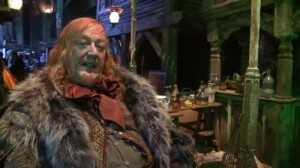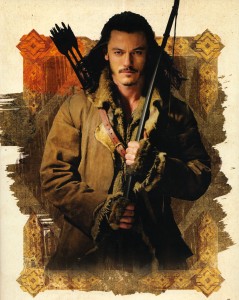Slavery, trademark of the Dark Lords

In particular, something which has not been revealed currently is whether or not the Lake-men, and in particular Bard or the Master of Lake-town, figure in the Necromancer story.
Stephen Fry stated in a 2012 interview that Bard is “heroic” and “rides and hunts” in the vicinity of Esgaorth. But what is Bard “hunting”? Food? Or something else? We already know that Legolas and Tauriel will fight the Necromancer’s spiders, at the very least.
Are other fell creatures lurking in the vicinity of the Riving Running, and being kept away from the people of Lake-town by Bard? What is he doing, bow and arrow in hand, when he finds Bilbo and the Dwarves drawing close to Esgaroth?
Then there’s the recent reveal from the 2014 annual that Alfrid, a “very creepy” man of Lake-town, is in fact ostensibly a “slave” to the Master? Slavery is a trademark state of the Dark Lords, Morgoth and Sauron.
Indeed, look for any trace of slavery or thralldom in The Hobbit or The Lord of the Rings, and Sauron or Saruman are responsible (save the Army of the Dead, who are arguably not acting of their own free will, though they are forced into service by Aragorn with promise of eventual freedom rather than through the oppression of his enemies).
Already it seems that Stephen Fry’s Master of Lake-town might be a human analogue for Smaug — but might he be an even darker character, possibly purposely ignoring the rise of the Necromancer (or even being a slave to Sauron himself)?
Or is his simply the corrupt politician that he was in the novel?
Bard, Beorn and Azog — a spiders’ web of events

Beorn will have an animosity of Azog. According to the 2014 annual, he hates Azog wiping out the other shape-shifters in Middle-earth — in fact, Beorn only gives Thorin’s company shelter when he learns they are being pursued by Azog.
Legolas and Tauriel will fight both the Necromancer’s spiders as revealed in interviews and a LEGO playset (the same spiders Radagast discovered came from the Hill of Sorcery in An Unexpected Journey), and of course, Azog’s hunters; and Bard will encounter the Gundabad Orcs at least once.
If Azog is under the command of, or at least allied with, Sauron, all of these characters will play a part in combating the Necromancer’s fell creatures. It has become apparent that Bard and the elves have more to do than in the book — as does Beorn, according to Peter Jackson.
Is there some Maia pulling all the strings?
Does this “something more” include a part in the Necromancer story proper, or will it simply involve the aforementioned battle scenes?
According to Peter Jackson’s recent interview with Empire, The Desolation of Smaug will contain multiple story-threads — the dwarves, the Lake-men, the Wood-elves, the orcs; will Sauron be the common presence who binds these stories together, a-la The Lord of the Rings? And who in the extensive ensemble will be present at the Battle of Dol Guldur (other than the wizards and presumably Galadriel)?
Time will tell.


